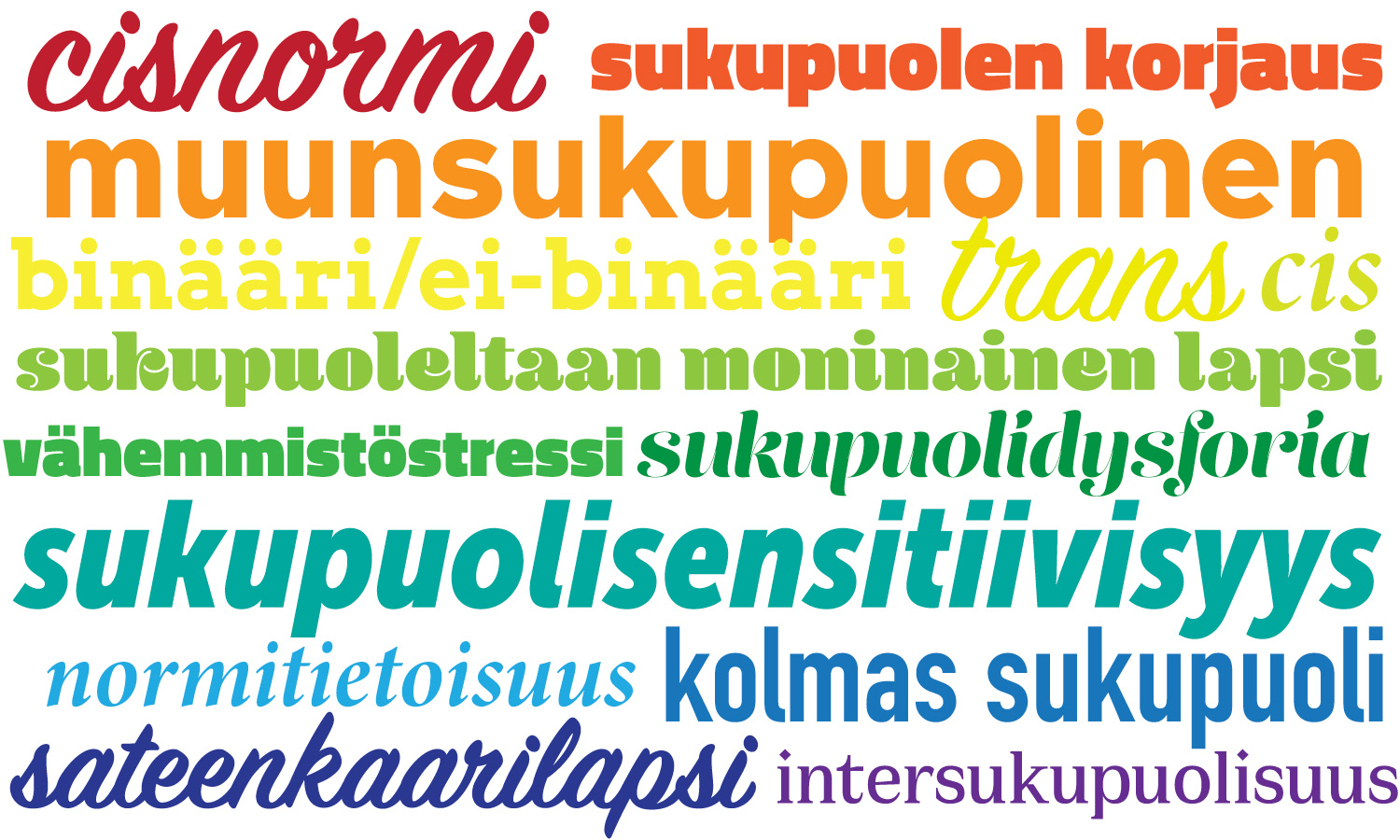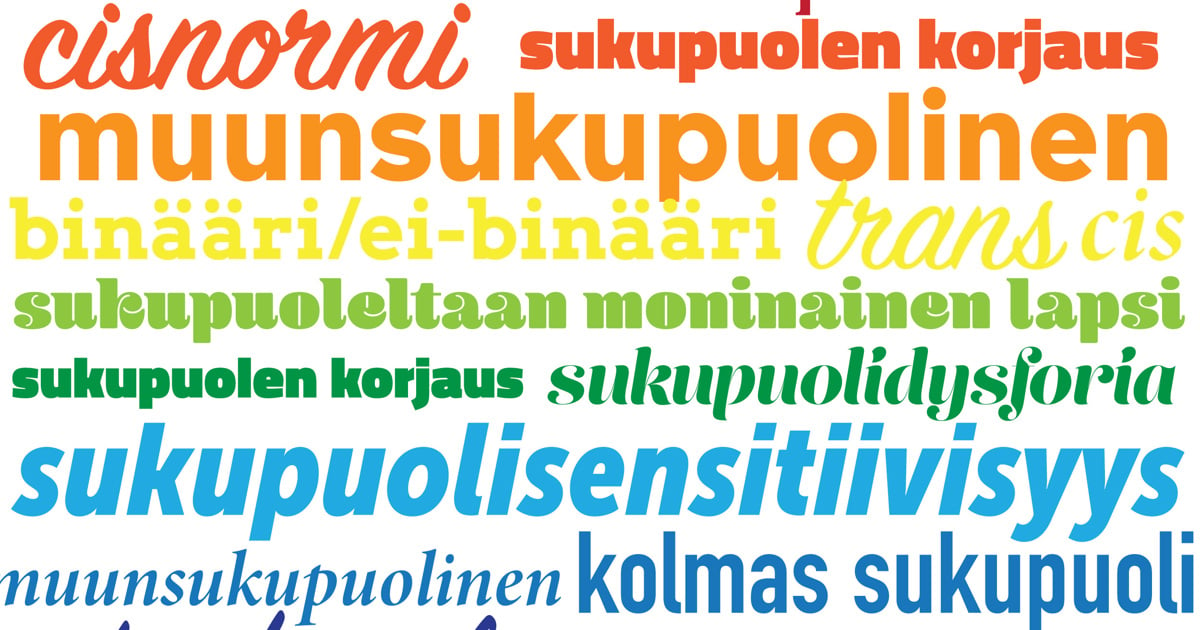
Sanoma Media Finland´s sustainability network has picked the essential and topical terms of gender diversity together with the Helsinki Pride community. The aim is to introduce the terms relating to minorities and increase awareness and understanding of diversity within Sanoma and in the surrounding society.
“The words concerning gender diversity become familiar only when they are read, written and talked about. In order to be able to comprehend gender diversity and be norm-critical, we must have a basic understanding of the norms,” says Annu Kemppainen, Executive Director at Helsinki Pride.
The glossary explains the most common words describing gender diversity. A more comprehensive glossary can be found on the Seta and Gender Diversity & Intersex Centre of Expertise websites, for example.
Everyone should familiarise themselves with these terms to be able to discuss the diversity of genders in a way that respects human dignity and not offend anyone out of ignorance.
Gender diversity. This concept refers to gender being a diverse phenomenon that cannot be divided into binary opposite and clearly distinguishable genders. Gender diversity includes both gender minorities and gender majorities. At the individual level, it is possible to think that each person’s gender is comprised of unique and individual traits and is thus diverse.
Norm awareness. Norms refer to society’s prevailing notions and unwritten rules of what is considered “normal” and desirable. A norm-aware approach acknowledges and questions the norms and seeks to dismantle harmful norms.
Minority stress. Minority stress refers to a chronic state of stress that is caused by, among other things, the gender and heterosexual assumptions of the surrounding society, feelings of being different, feelings of otherness, social stigma and experiences of bullying and violence. It refers to an individual’s social and internal pressure caused by being in a minority group. Minority stress can have adverse impacts on both physical and mental health and well-being.
Binary/non-binary. Binary means twofold. Gender identity can be binary or non-binary. A non-binary person is someone whose gender identity does not fit in the twofold form of male–female. They can, for example, be non-binary, agender or intergender.
Cis. The word “cis” is used to describe a person whose gender identity and expression corresponds with the gender assigned to them at birth and the expectations usually associated with it in their culture. The majority of people are cisgender. Cis is the opposite of trans; the words are originally from Latin, where they mean “on this side” and “on the other side”. A cis male was registered as a boy at birth. A cis female was registered as a girl at birth.
Trans. The word is used to describe a person whose gender or gender expression does not unequivocally correspond with the gender assigned to them at birth and the expectations commonly associated with it, and identify themselves as trans persons. The opposite is cis; the words are originally from Latin, where they mean “on this side” and “on the other side”.
Cis norm. Cis norm is our society’s and culture’s thought model and unwritten rule, according to which all people experience the gender assigned to them at birth as their own and unequivocally express it.
Intersex refers to a number of body variations in which gendered traits, such as chromosomes, genitalia or hormone activity are not unequivocally typical of female or male. Intersex is natural body variation and makes it visible that people cannot be classified into two exclusive genders biologically, either. Intergender can also be a gender identity for some.
Third gender. The concept can be used in various ways. In common speech and anthropology, for example, the concept of third gender refers to there being more genders than two. It does not mean that there are three genders; as an umbrella concept, it disrupts gender binarism. With regard to legal gender categories, third gender refers to the possibility of selecting a gender other than male or female.
A non-binary person can be either a male or a female, something between masculinity and femininity or completely outside this binarism. Non-binary can also be an umbrella concept for other non-binary gender identities, such as gender fluid, gender queer and agender. The term transgender was previously used as a synonym of non-binary. The English word transgender refers to transsexual people. Not everyone outside gender binarism feel the term non-binary as their gender identity.
A rainbow child is a child whose gender identity or gender expression differ from the expectations associated with the gender assigned to them at birth or whose age-specific infatuations target those of the same or the same and different gender.
A gender diverse child. The term can be used for children whose gender identity and/or expression occasionally or all the time differs from the expectations for the gender assigned to them at birth.
Gender affirmation. Gender affirmation usually means medical treatments with which a transgender or non-binary person can alter their body to correspond with their identified gender. Gender affirmation is both a social and a legal process. Legal gender affirmation refers to changing the gender entry in the population information system
Agender. Not all people have an identified gender. For some, on the other hand, agender can be the identified gender.
Gender dysphoria. Gender dysphoria means the comprehensive distress due to a gender mismatch; it is often divided into body dysphoria and social dysphoria. Body dysphoria refers to feelings of estrangement, anxiety and loathing towards the gendered traits of the body. Social dysphoria refers to the anxiety and distress occurring in social situations; it is associated with misgendering, i.e. not being seen as oneself in the situations.
Gender sensitivity is a mindset that takes gender and the associated norms and their impacts into consideration at the level of both the individual and society. The term gender sensitivity is used in particular in early childhood education and youth work. As a goal of upbringing, it means that upbringing makes room for every child to be girls, boys or children that identify themselves in other ways of their own kind. In education, the term gender awareness is most commonly used.
Source: Gender Diversity & Intersex Centre of Expertise
How to take gender and sexual diversity into account at the workplace – six tips for language use and speech
- Consider whether it is essential to know or bring up a person’s gender. Do not assume or assign genders without permission. Preferably, use alternative more descriptive words than gender. Ask the person themselves which term they prefer to be used.
- Do not make assumptions concerning family relationships. Use neutral terms, such as spouse, partner, relationship, relationships. Good questions include: what is your family like? Who are there in your family?
- When recruiting, consider your unidentified biases and be aware of the human tendency to hire people who feel like ourselves. Replace gendered terms with equal ones: foreman -> supervisor.
- Consider diversity when choosing people for photos or events, for example. Ask yourself what kind of assumptions you make with regard to certain professions or relationships.
- Be sensitive when using English pronouns. You can give your own pronoun in the e-mail signature, for example, such as “she/her”. “They/them” is used both in a singular and a plural sense.
